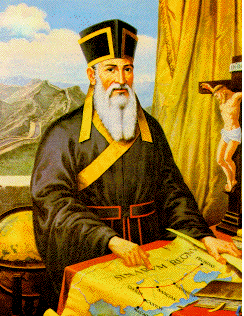Elegant collision between East and West
The China-France Cultural Year 2005 began with a special exhibition at the Meridian Gate. A hundred royal treasures from the reign of French King Louis XIV were on display at the Forbidden City. The exhibit was France's answer to the exhibition on Emperor Kangxi previously held in the Chateau de Versailles.
  |
|
Louis XIV and Emperor Kangxi |
In the 17th century, both Louis XIV and Emperor Kangxi had a common desire to learn about the world, and cultural exchange between the two countries was common. European missionaries brought Western art and science to China. Chinese art and influences made their way around the European artistic and literary circuits.
Both rulers were interested in meeting each other. Although attempts had been made by King Louis to gain an audience with the emperor, fate would keep the two men apart for the duration of their lifetimes. On August 6, 1688, King Louis even wrote a letter to Emperor Kangxi, but the letter never made it into his hands. The mission Louis had intended the letter to travel with failed to materialize, and the letter is now kept in the French Foreign Affaires Archives.
Although during their lifetimes a face-to-face meeting seemed impossible, little did they know that they would meet symbolically in the future under the most extraordinary circumstances, through exhibitions held by their respective countries.
Elaborate Clocks and Access to Emperors
|
|
|
|
The main goal for the missionaries from Europe was to preach Christianity. They thought the best way was to first reach the Chinese emperors in person. But the rigorous hierarchical system and deep-rooted Confucian culture made it impossible.
The missionaries thought of advanced Western science and exotic foreign art, to attract the attention of China's highest rulers.
It was the elaborate clocks the Italian missionary Matteo Ricci brought that first caught the attention of the Ming emperor, and opened the door to the Forbidden City.
Matteo Ricci's Clocks
|
|
At the age of 58 on May 3, 1610, Ricci died in Beijing. Under the rules of the Ming Dynasty, Matteo should have been buried in Macao. But the emperor allowed him to be buried in Beijing due to his contributions to science. |
The key to the Forbidden City for Matteo Ricci turned out not to be a key at all. Ricci had gained notice from Chinese elites through his introduction of a variety of Western scientific and religious gadgetry, such as prisms, maps and crucifixes.
In 1601 Ricci was summoned to the Forbidden City by Emperor Wanli (1563-1620), the first Westerner to visit the palace. As a gift, Ricci brought two clocks to give to the Emperor. Wan Li displayed no interest in the Christianity that Ricci intended on preaching. He was, however, enthralled by the two clocks Ricci had presented. In order to listen to the sound of the gongs of the clocks as quickly as possible, Emperor Li summoned Ricci to the palace for a demonstration.
Historical records say the bigger clock struck once at 1 p.m. and 12 times at midnight and noon. The smaller clock struck once every 15 minutes and four times at each hour. On the outside, the clocks were a mysterious meeting of time and sound. On the inside they were a complex network of gears and shiny bits.
Wanli liked the clocks so much that he allowed Ricci to stay in Beijing, the capital. With the emperor's permission, Ricci was able to enter the Forbidden City and adjust the clocks for the emperor.
It took three days for Ricci to teach the eunuchs the mechanics of the clocks and how to adjust them.
Although the doors of the palace were opened to the Italian missionary, he did not manage to meet the emperor in person. The only chance he had to see the emperor was in the imperial court where Ricci and other high officials knelt to the throne seat. Emperor Wanli had long been enjoying his life within the palace and leaving the court matters to his officials.
As a gift for his clocks, the emperor permitted Ricci to build a church in southern Beijing.
























